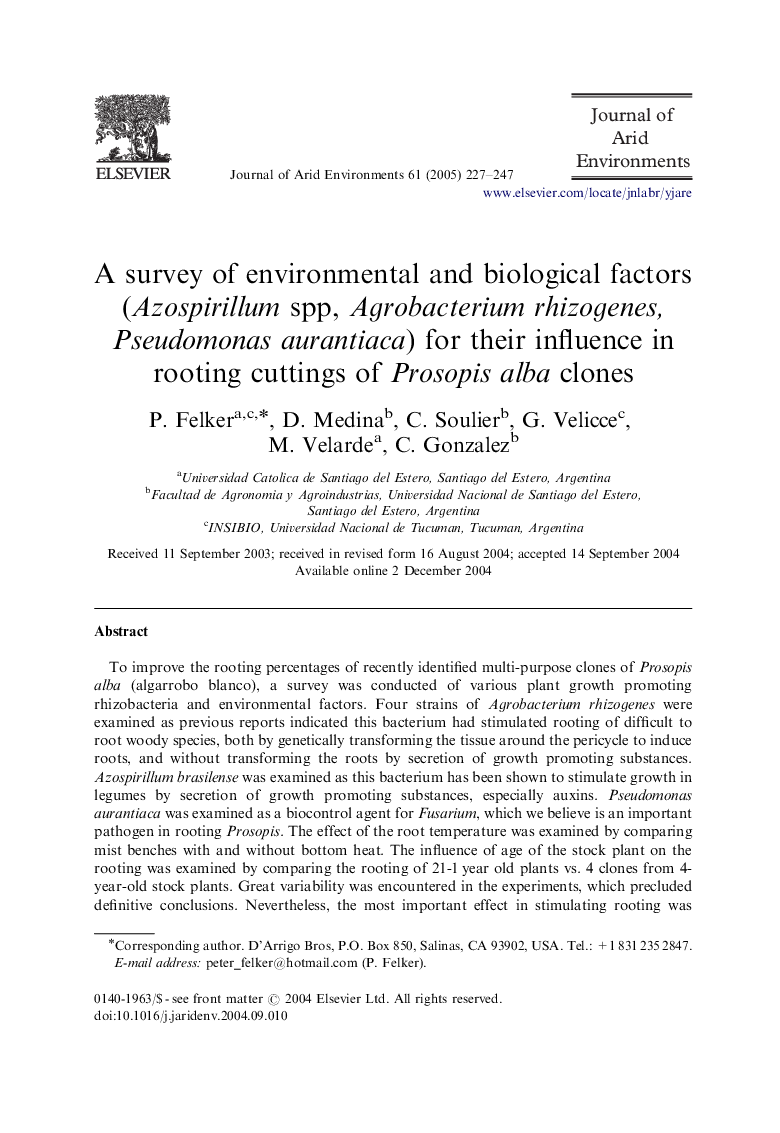| کد مقاله | کد نشریه | سال انتشار | مقاله انگلیسی | نسخه تمام متن |
|---|---|---|---|---|
| 9447918 | 1305575 | 2005 | 21 صفحه PDF | دانلود رایگان |
عنوان انگلیسی مقاله ISI
A survey of environmental and biological factors (Azospirillum spp, Agrobacterium rhizogenes, Pseudomonas aurantiaca) for their influence in rooting cuttings of Prosopis alba clones
دانلود مقاله + سفارش ترجمه
دانلود مقاله ISI انگلیسی
رایگان برای ایرانیان
موضوعات مرتبط
مهندسی و علوم پایه
علوم زمین و سیارات
فرآیندهای سطح زمین
پیش نمایش صفحه اول مقاله

چکیده انگلیسی
To improve the rooting percentages of recently identified multi-purpose clones of Prosopis alba (algarrobo blanco), a survey was conducted of various plant growth promoting rhizobacteria and environmental factors. Four strains of Agrobacterium rhizogenes were examined as previous reports indicated this bacterium had stimulated rooting of difficult to root woody species, both by genetically transforming the tissue around the pericycle to induce roots, and without transforming the roots by secretion of growth promoting substances. Azospirillum brasilense was examined as this bacterium has been shown to stimulate growth in legumes by secretion of growth promoting substances, especially auxins. Pseudomonas aurantiaca was examined as a biocontrol agent for Fusarium, which we believe is an important pathogen in rooting Prosopis. The effect of the root temperature was examined by comparing mist benches with and without bottom heat. The influence of age of the stock plant on the rooting was examined by comparing the rooting of 21-1 year old plants vs. 4 clones from 4-year-old stock plants. Great variability was encountered in the experiments, which precluded definitive conclusions. Nevertheless, the most important effect in stimulating rooting was obtained by increasing the root temperature of the cuttings to about 33 °C, even when daily maximum air temperatures were 40 °C. The second most important factor seemed to be the age of the stock plant. Future research should be aimed at methods to rejuvenate the tissue, possibly by grafting onto immature seedlings. Of the rhizobacteria, the Pseudomonas seemed to have the greatest potential. Azospirillum, which often serves as “a helper bacterium”may have stimulated rooting in a synergistic way that is difficult to measure. The Tiger 232 strain of A. rhizogenes was selected from among the 4 A. rhizogenes strains as giving some of the most consistent results. When indolebutyric acid, napthaleneacetic acid, thiamine HCl, 33 °C root temperatures were combined with A. rhizogenes and Azospirillum, the mean rooting percentage and number of roots per cutting for 21-year old P. alba plants were 80% and 30, respectively. In contrast, 50% rooting was observed for four, 4-year-old stock plants. The rooting parameters for the young stock plants are much greater than obtained in earlier work on Prosopis (80% rooting with a maximum of 12 roots/cutting) and suggests that in spite of lack of significant treatment effects, these rhizobacteria may stimulate rooting.
ناشر
Database: Elsevier - ScienceDirect (ساینس دایرکت)
Journal: Journal of Arid Environments - Volume 61, Issue 2, April 2005, Pages 227-247
Journal: Journal of Arid Environments - Volume 61, Issue 2, April 2005, Pages 227-247
نویسندگان
P. Felker, D. Medina, C. Soulier, G. Velicce, M. Velarde, C. Gonzalez,